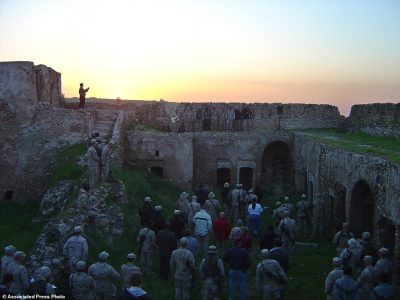
ISIS terrorists destroy the oldest Christian monastery that has stood for 1,400 years
The oldest Christian monastery in Iraq, which had survived for more than 1,400 years, has been reduced to a field of rubble by ISIS fighters, satellite images confirm.
St. Elijah’s Monastery, south of Mosul, northern Iraq, has been completely wiped out by the Islamist terrorist, joining a list of dozens of historical and religious sites purposely destroyed by the group.
Experts believe ISIS fighters would have used every measure available to destroy the monastery, which had most recently served as a place of worship for U.S. troops, including bulldozers, sledgehammers and possibly explosives.
It is believed the 1,400 years old monastery was leveled at some point between August 27 and September 28 in 2014, after ISIS took control of the area in June that year.
During it’s reign of terror in Iraq and Syria, ISIS has forced out hundreds of thousands of Christians, threatening a religion that has endured in the region for 2,000 years.
Along the way, its fighters have destroyed buildings and ruins historical and culturally significant structures they consider contrary to their interpretation of Islam.
St. Elijah’s has joined a growing list of more than 100 demolished religious and historic sites, including mosques, tombs, shrines and churches in Syria and Iraq.
The extremists have defaced or ruined ancient monuments in Nineveh, Palmyra and Hatra. Museums and libraries have been looted, books burned, artwork crushed — or trafficked.
Before it was razed, images show a partially restored, 27,000-square-foot religious building. Although the roof was largely missing, it had 26 distinctive rooms including a sanctuary and chapel.
One month later, ‘the stone walls have been literally pulverized,’ said imagery analyst Stephen Wood, CEO of Allsource Analysis
‘Bulldozers, heavy equipment, sledgehammers, possibly explosives turned those stone walls into this field of gray-white dust. They destroyed it completely,’ he said. ‘There’s nothing to rebuild.’
The monastery, called Dair Mar Elia, is named for the Assyrian Christian monk – St. Elijah – who built it between 582 and 590 A.C. It was a holy site for Iraqi Christians for centuries, part of the Mideast’s Chaldean Catholic community.
In 1743, tragedy struck when as many as 150 monks who refused to convert to Islam were massacred under orders of a Persian general, and the monastery was damaged. For the next two centuries it remained a place of pilgrimage, even after it was incorporated into an Iraqi military training base and later a U.S. base.
Then in 2003 St. Elijah’s shuddered again — this time a wall was smashed by a tank turret blown off in battle. Iraqi troops had already moved in, dumping garbage in the ancient cistern. The U.S. Army’s 101st Airborne Division took control, with troops painting over ancient murals and scrawling their division’s ‘Screaming Eagle,’ along with ‘Chad wuz here’ and ‘I love Debbie,’ on the walls.
A U.S. military chaplain, recognizing St. Elijah’s significance, kicked the troops out and the Army’s subsequent preservation initiative became a pet project for a series of chaplains who toured thousands of soldiers through the ruin.
‘It was a sacred place. We literally bent down physically to enter, an acquiescence to the reality that there was something greater going on inside,’ remembered military chaplain Jeffrey Whorton. A Catholic priest who now works at Ft. Bragg, he had to collect himself after viewing the damage. ‘I don’t know why this is affecting me so much,’ he said.
In his office in exile in Irbil, Iraq, the Rev. Paul Thabit Habib, 39, stared quietly at before- and after-images of the monastery that once perched on a hillside above his hometown of Mosul. Shaken, he flipped back to his own photos for comparison.
‘I can’t describe my sadness,’ he said in Arabic. ‘Our Christian history in Mosul is being barbarically leveled. We see it as an attempt to expel us from Iraq, eliminating and finishing our existence in this land.’
‘A big part of tangible history has been destroyed,’ said Rev. Manuel Yousif Boji. A Chaldean Catholic pastor in Southfield, Michigan, he remembers attending Mass at St. Elijah’s almost 60 years ago while a seminarian in Mosul.
‘These persecutions have happened to our church more than once, but we believe in the power of truth, the power of God,’ said Boji.
He is part of the Detroit area’s Chaldean community, which became the largest outside Iraq after the sectarian bloodshed that followed the U.S. invasion in 2003. Iraq’s Christian population has dropped from 1.3 million then to 300,000 now, church authorities say.
The destruction of the monastery is a blow for U.S. troops and advisers who served in Iraq and had tried to protect and honor the site, a hopeful endeavor in a violent place and time.
Suzanne Bott, who spent more than two years restoring St. Elijah’s Monastery as a U.S. State Department cultural adviser in Iraq, reportedly cried when she saw the images.
‘Oh no way. It’s just razed completely,’ said Bott. ‘What we lose is a very tangible reminder of the roots of a religion.’
Army reserve Col. Mary Prophit remembered a sunrise service in St. Elijah where, as a Catholic lay minister, she served communion.
‘I let that moment sink in, the candlelight, the first rays of sunshine. We were worshipping in a place where people had been worshipping God for 1,400 years,’ said Prophit, who was deployed there in 2004 and again in 2009.
‘I would imagine that many people are feeling like, ‘What were the last 10 years for if these guys can go in and destroy everything?” said Prophit, a library manager in Glenoma, Washington.
Source: Daily Mail





